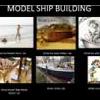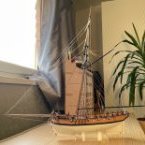-
Posts
257 -
Joined
-
Last visited
About acaron41120

- Birthday 12/30/1947
Profile Information
-
Gender
Male
-
Location
Daytona Beach, FL
-
Interests
Wood model ships, VWs, flying and golf
Recent Profile Visitors
-
I see your bottom hull panel is one piece compared to my older kit which has a two-piece hull bottom. And your hull bottom and transom are plywood where mine are Walnut. I decided to replace my pieces with plywood. Walnut is harder to work. Also I'm adding the motor unit for the paddlewheel. I'll have to make the motor mounts as they show in Artesania Latina's video. That's when I get back home in January.
-
 Geordie Tyne reacted to a post in a topic:
Changing Profile Location
Geordie Tyne reacted to a post in a topic:
Changing Profile Location
-
 Geordie Tyne reacted to a post in a topic:
Changing Profile Location
Geordie Tyne reacted to a post in a topic:
Changing Profile Location
-
 Keith Black reacted to a post in a topic:
Warped Dowel for Small Masts
Keith Black reacted to a post in a topic:
Warped Dowel for Small Masts
-
 Gregory reacted to a post in a topic:
Warped Dowel for Small Masts
Gregory reacted to a post in a topic:
Warped Dowel for Small Masts
-

Warped Dowel for Small Masts
acaron41120 replied to acaron41120's topic in Masting, rigging and sails
I'm now kind of leaning towards soaking the dowel for a couple of hours and adapting an old building board/wood cutting board so I can insert the dowel between two similar thickness pieces of flat wood and secured with a couple of screws and then run a hot iron over it for a bit to steam out the bend. Then close up the space and rinse, lather and repeat until the dowel I straight. Any thoughts on my idea are appreciated. -
 Keith Black reacted to a post in a topic:
Warped Dowel for Small Masts
Keith Black reacted to a post in a topic:
Warped Dowel for Small Masts
-

Warped Dowel for Small Masts
acaron41120 replied to acaron41120's topic in Masting, rigging and sails
Hmm...Kieth Black. I wonder if my electric plank bender will work as a plank straightener? You know, soak the 4mm diameter dowel and steam bend the dowel where the bend is to straighten it out. -
 Keith Black reacted to a post in a topic:
Warped Dowel for Small Masts
Keith Black reacted to a post in a topic:
Warped Dowel for Small Masts
-
Just inventoried my King of the Mississippi riverboat kit and all is there and good except (and there I always an except) I have one 4mm diameter x 590mm Bokapi wood dowel that is bowed in the middle. As we do with flat pieces of wood where we soak them for a few hours and then lay them under a weighted board, will that method work as well for a 4mm diameter dowel. Or is there some other method? Don't want to try to hunt down a 4mm Bokapi wood dowel. Thanks in advance for any assistance.
-
 alde reacted to a post in a topic:
Spiling Advice for the Novice
alde reacted to a post in a topic:
Spiling Advice for the Novice
-
 shauer reacted to a post in a topic:
HMS Winchelsea 1764 by acaron41120 - 1:48
shauer reacted to a post in a topic:
HMS Winchelsea 1764 by acaron41120 - 1:48
-
 Edwardkenway reacted to a post in a topic:
HMS Winchelsea 1764 by acaron41120 - 1:48
Edwardkenway reacted to a post in a topic:
HMS Winchelsea 1764 by acaron41120 - 1:48
-
To all modelers who are new or semi-experienced, spiling could be a conundrum. Yes, there are many different articles and book sections/chapters that explain it; sort of. I was in the same predicament as many of us have been but here's a suggestion. Yes, read about how to do spiling but then put the book down and get out there and try it out. Yes, you MAY mess it up but try it again and you'll get it. For me it just sort of happened after I got tired of reading and said to myself, "Self...get in your boat shed and just try spiling." Wouldn't you know it...after looking at my first try mess-up for a few minutes, the light came on and on my second try everything just fell in place. So if you're bothered by spiling or if the subject just makes you cringe, just tell yourself, "Self! Get out there and start spiling!"
-

What Am I Missing
acaron41120 replied to acaron41120's topic in Building, Framing, Planking and plating a ships hull and deck
Thanks for all the help. I erased all the pencil marks again and used a piece of white cardboard. Set on the top of the garboard strake and ran it all the way up to the bottom of the wale and marked it. Then I measured from the edge of the cardboard to the mark with a cloth tape measure and came up with 156mm. Then I remeasured with a metric ruler and came up with 148mm. So I took the cloth tape measure and laid it along the metric ruler and what a difference. At 100mm on the ruler the tape was 108mm. So the tape went back to the sewing box. I divided the 148 by 3 and came up with three bands each 49mm. I used the card and made my marks and the bands now are really close. Off by 0.3mm by the calipers. So I was relying on a fault marked tape. Thanks for all your much appreciated help Thomas I believe I have that same book you show here but have not read it yet. But I’ll definitely fish it out of my library and give it a good read. -
Trying the planking method in Donald Dressel’s book “Planking Techniques for Model Ship Building” with setting up the bands rather than my normal way of planking. I have installed the wale and the garboard plank. Measuring the distance from the bottom of the wale to the top of the garboard plank this measurement is 156mm. Next I take that measurement and divide by 3 (for the number of bands I want) and that comes out to three 52mm bands. BUT…when I measure the space of the bands along the middle frame I get 52 for the top, 52 for the bottom and 66 for the middle. Add those numbers up and it does not come out to 156mm, it comes out to 170mm. Should I add 7 to the top and bottom band making them all 59mm? If I do that the numbers don’t come out correct (59+59+59=177) but the total space is only 156mm. I might just say the heck with it and go with my normal way? I have read Donald Dressel’s book several times and thought I understood it but evidently not. What am I missing here? Any help appreciated.
-

new kit alert! New kit on the horizon - Winchelsea Nef
acaron41120 replied to James H's topic in Wood ship model kits
I agree with Bolin. You often see the Viking longboats like the Oseberg or the Roar Ege so when something different from this era comes out my interest is piqued. When this kit is released will it be through NRG?- 15 replies
-
- winchelsea
- medieval
-
(and 1 more)
Tagged with:
-
Siren I feel your pain. I'm building Billing Boats Golden Hind. The plans show three Wales. From everything I have read about the wale location is that the Wales is located "at the widest part of the ships hull." This doesn't seem that it will work well in that if followed, the bottom wale would be BELOW the waterline. So I'm going to go with the middle wale of the three which is a little above the center of the hull. The only other question is; because Billings doesn't double plank their hulls, do I double the thickness of the Wales? I've a few wider plants that I can use.
-
I have read in various publications about securing hull plank with glue and a wooden pins/peg (bamboo), especially at the bow on blunt shaped hulls. I have a 1:50 scale ship and a lot of 1/32" diameter dowels donated from a friend's project. Would the diameter of these pins/pegs be too large? Any advice would be helpful. Thanks.
-
I purchased the Billing Boats Golden Hind and the kit supplied deck planks are .5x8x780mm. I find the planks to be a tad bit too thin for my liking and wider than they actually should be. I'm thinking of ordering about sixty 0.7x7x550mm planks made of basswood. This appears to be a better plank for the 1/60 scale model. But really not certain what the color of the decks planks were during that period; light, medium or dark wood. For reference, I am staining the hull a light brown. Your thoughts are greatly appreciated.
About us
Modelshipworld - Advancing Ship Modeling through Research
SSL Secured
Your security is important for us so this Website is SSL-Secured
NRG Mailing Address
Nautical Research Guild
237 South Lincoln Street
Westmont IL, 60559-1917
Model Ship World ® and the MSW logo are Registered Trademarks, and belong to the Nautical Research Guild (United States Patent and Trademark Office: No. 6,929,264 & No. 6,929,274, registered Dec. 20, 2022)
Helpful Links
About the NRG
If you enjoy building ship models that are historically accurate as well as beautiful, then The Nautical Research Guild (NRG) is just right for you.
The Guild is a non-profit educational organization whose mission is to “Advance Ship Modeling Through Research”. We provide support to our members in their efforts to raise the quality of their model ships.
The Nautical Research Guild has published our world-renowned quarterly magazine, The Nautical Research Journal, since 1955. The pages of the Journal are full of articles by accomplished ship modelers who show you how they create those exquisite details on their models, and by maritime historians who show you the correct details to build. The Journal is available in both print and digital editions. Go to the NRG web site (www.thenrg.org) to download a complimentary digital copy of the Journal. The NRG also publishes plan sets, books and compilations of back issues of the Journal and the former Ships in Scale and Model Ship Builder magazines.




